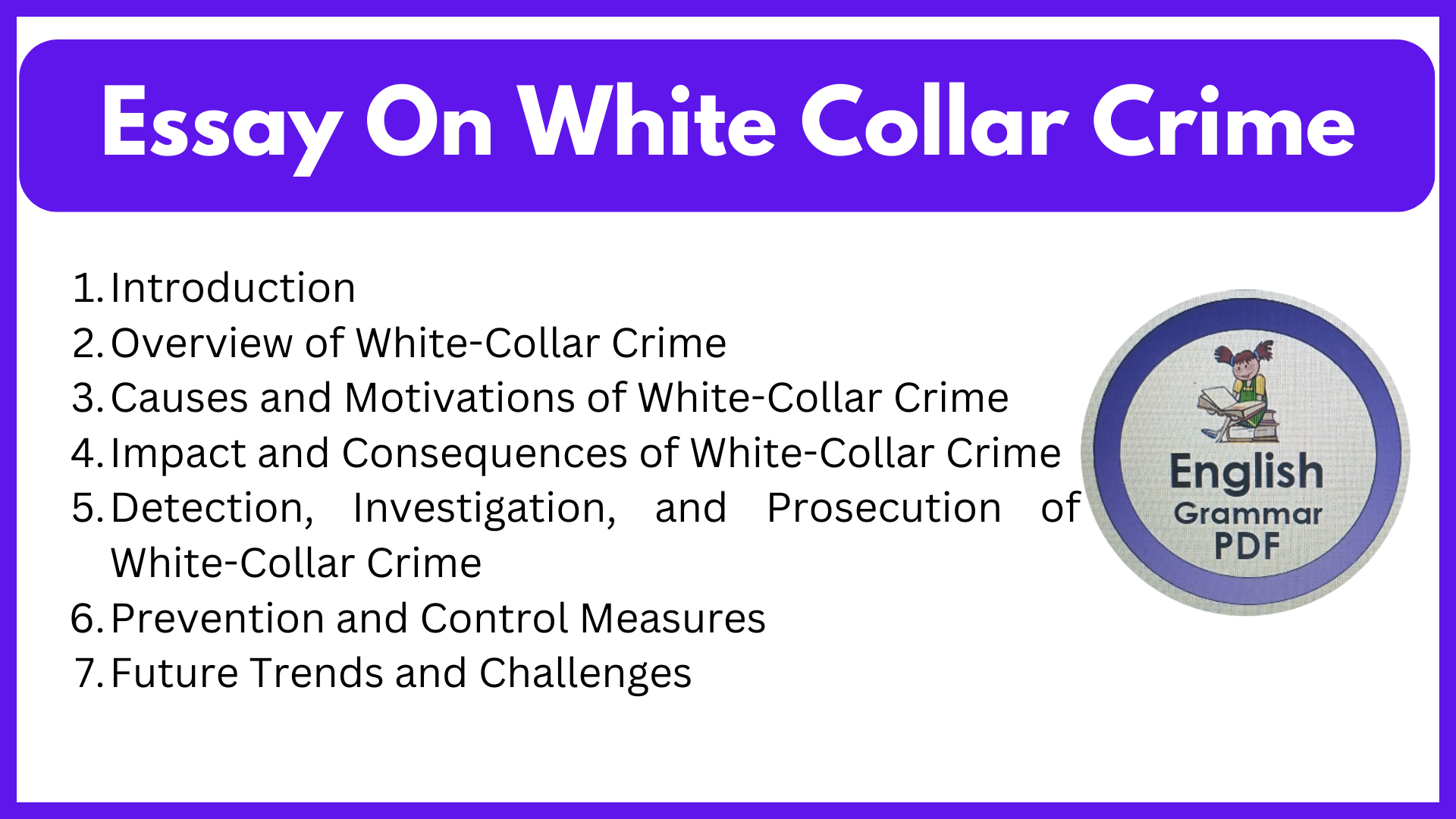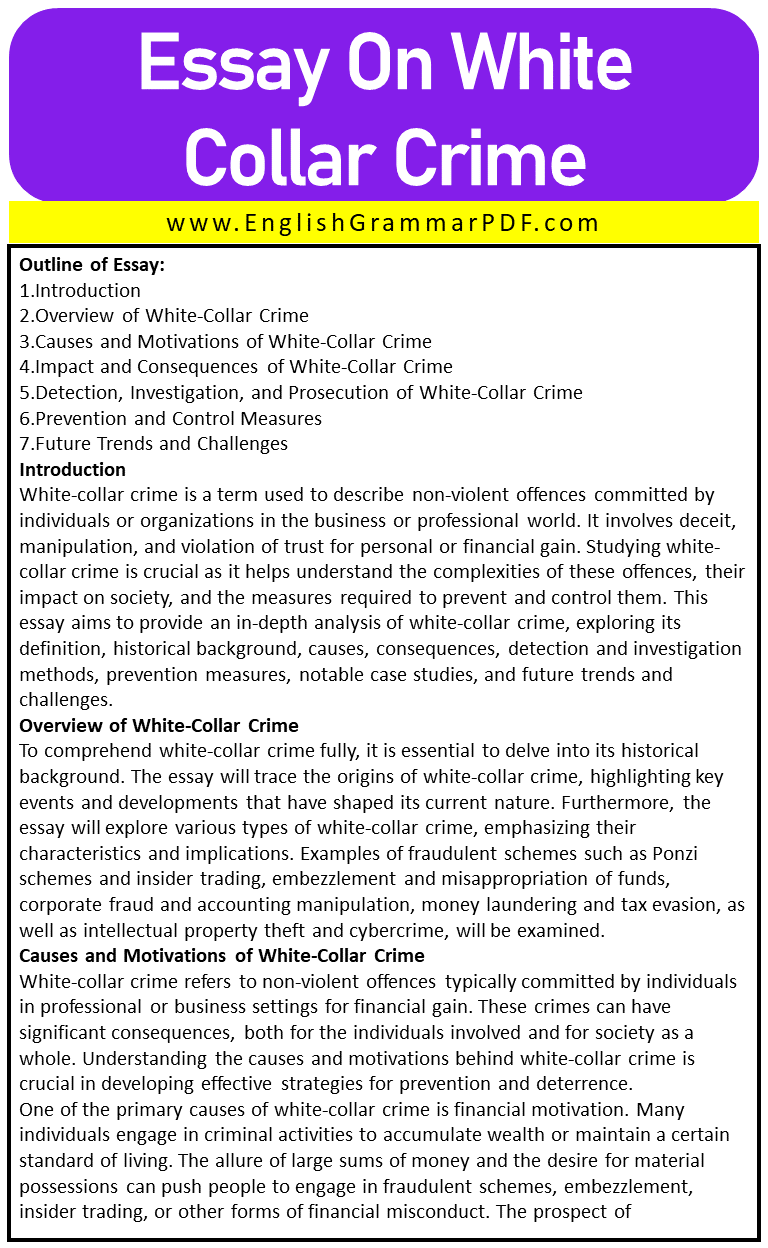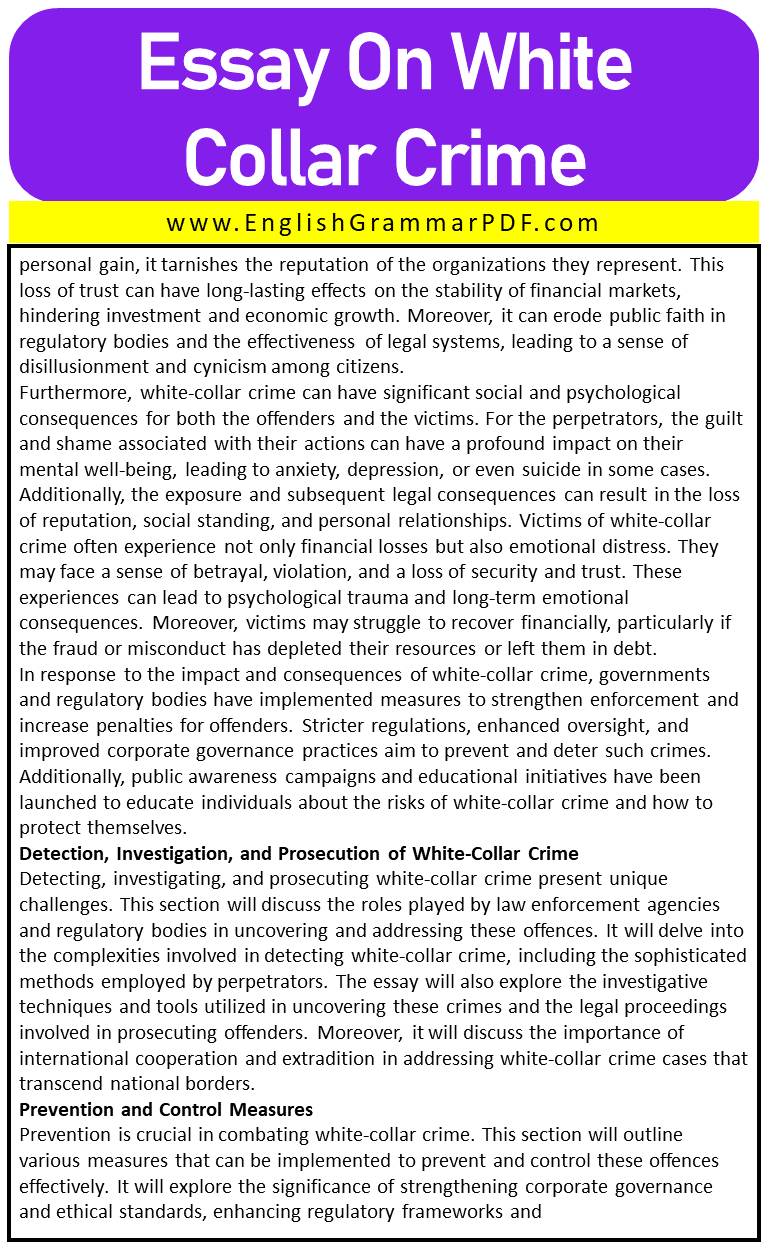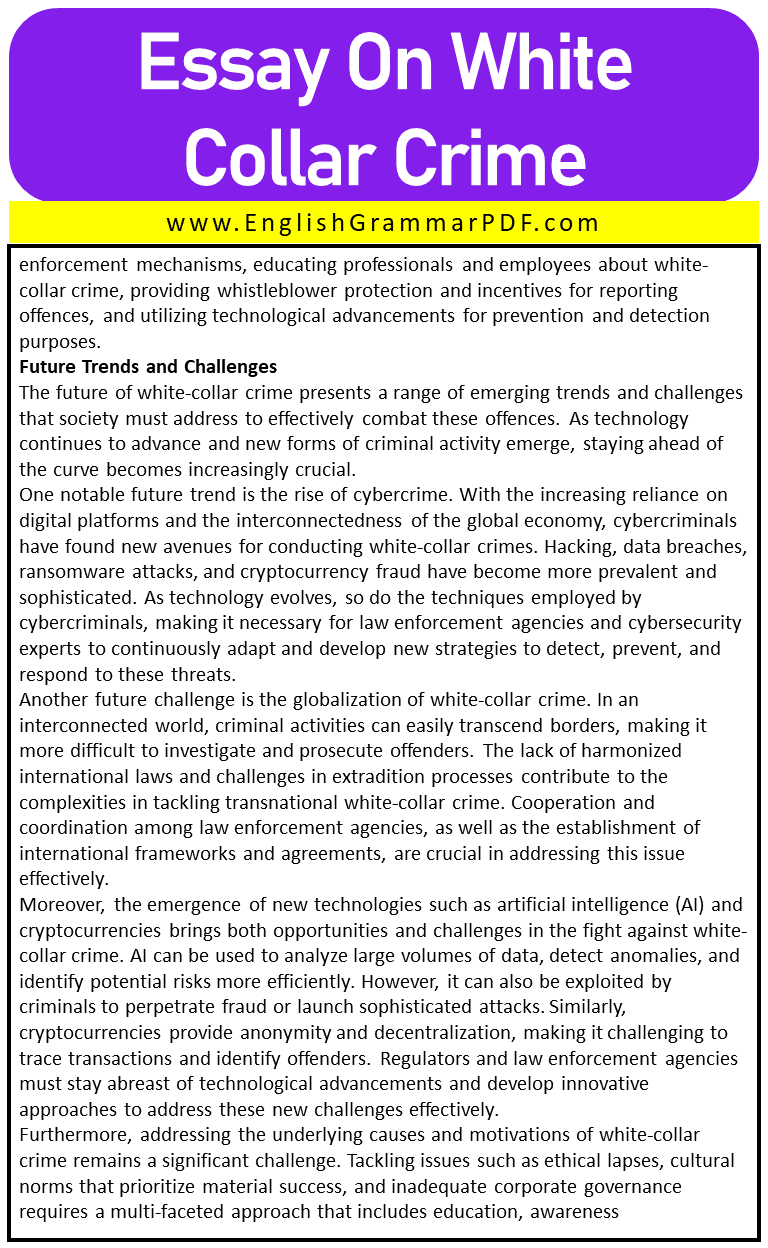Essay On White Collar Crime
Outline of Essay:
- Introduction
- Overview of White-Collar Crime
- Causes and Motivations of White-Collar Crime
- Impact and Consequences of White-Collar Crime
- Detection, Investigation, and Prosecution of White-Collar Crime
- Prevention and Control Measures
- Future Trends and Challenges
Introduction
White-collar crime is a term used to describe non-violent offences committed by individuals or organizations in the business or professional world. It involves deceit, manipulation, and violation of trust for personal or financial gain. Studying white-collar crime is crucial as it helps understand the complexities of these offences, their impact on society, and the measures required to prevent and control them. This essay aims to provide an in-depth analysis of white-collar crime, exploring its definition, historical background, causes, consequences, detection and investigation methods, prevention measures, notable case studies, and future trends and challenges.
Overview of White-Collar Crime
To comprehend white-collar crime fully, it is essential to delve into its historical background. The essay will trace the origins of white-collar crime, highlighting key events and developments that have shaped its current nature. Furthermore, the essay will explore various types of white-collar crime, emphasizing their characteristics and implications. Examples of fraudulent schemes such as Ponzi schemes and insider trading, embezzlement and misappropriation of funds, corporate fraud and accounting manipulation, money laundering and tax evasion, as well as intellectual property theft and cybercrime, will be examined.
Causes and Motivations of White-Collar Crime
White-collar crime refers to non-violent offences typically committed by individuals in professional or business settings for financial gain. These crimes can have significant consequences, both for the individuals involved and for society as a whole. Understanding the causes and motivations behind white-collar crime is crucial in developing effective strategies for prevention and deterrence.
One of the primary causes of white-collar crime is financial motivation. Many individuals engage in criminal activities to accumulate wealth or maintain a certain standard of living. The allure of large sums of money and the desire for material possessions can push people to engage in fraudulent schemes, embezzlement, insider trading, or other forms of financial misconduct. The prospect of personal gain, coupled with the belief that they can escape detection, often leads individuals to rationalize their actions and engage in illicit activities.
Another contributing factor to white-collar crime is opportunity. Individuals in positions of power or trust within organizations often have access to sensitive information, company funds, or assets. This access provides them with opportunities to exploit their positions for personal gain. Lack of effective oversight, weak internal controls, and inadequate regulatory frameworks can create an environment conducive to white-collar crime. The absence of checks and balances can embolden individuals to take advantage of their positions without fear of being caught.
Certain cultural and social factors can contribute to the prevalence of white-collar crime. Societal norms that emphasize material success, status, and competition may create a mindset that justifies engaging in illegal activities to achieve these goals. In some cases, individuals may feel pressured to engage in fraudulent behaviour to meet high expectations or to maintain a certain lifestyle. The desire for social recognition and acceptance can also drive individuals to engage in unethical practices.
Moreover, the rapid advancements in technology and globalization have opened up new avenues for white-collar crime. Cybercrime, such as hacking, identity theft, and online fraud, has become increasingly prevalent as more business and financial transactions occur online. The anonymity and global reach provided by the internet make it easier for criminals to commit offences across borders, making it challenging for law enforcement agencies to investigate and prosecute such crimes effectively.
Impact and Consequences of White-Collar Crime
White-collar crime, characterized by its non-violent nature and financial motivation, has far-reaching impacts and consequences on both individuals and society as a whole. The consequences of such crimes can be devastating, affecting not only the victims directly involved but also the overall economy and public trust in institutions.
One of the significant impacts of white-collar crime is financial loss. Individuals who fall victim to fraudulent schemes or financial misconduct can suffer significant financial harm, often losing their life savings or facing bankruptcy. Ponzi schemes, insider trading, and embezzlement can lead to substantial monetary damages for investors, employees, and shareholders. The ripple effect of these crimes can extend beyond immediate victims, impacting entire communities and even national economies, as seen in cases like the Enron scandal. White-collar crime also erodes public trust in institutions and undermines confidence in the financial system. When individuals in positions of power and authority abuse their positions for personal gain, it tarnishes the reputation of the organizations they represent. This loss of trust can have long-lasting effects on the stability of financial markets, hindering investment and economic growth. Moreover, it can erode public faith in regulatory bodies and the effectiveness of legal systems, leading to a sense of disillusionment and cynicism among citizens.
Furthermore, white-collar crime can have significant social and psychological consequences for both the offenders and the victims. For the perpetrators, the guilt and shame associated with their actions can have a profound impact on their mental well-being, leading to anxiety, depression, or even suicide in some cases. Additionally, the exposure and subsequent legal consequences can result in the loss of reputation, social standing, and personal relationships. Victims of white-collar crime often experience not only financial losses but also emotional distress. They may face a sense of betrayal, violation, and a loss of security and trust. These experiences can lead to psychological trauma and long-term emotional consequences. Moreover, victims may struggle to recover financially, particularly if the fraud or misconduct has depleted their resources or left them in debt.
In response to the impact and consequences of white-collar crime, governments and regulatory bodies have implemented measures to strengthen enforcement and increase penalties for offenders. Stricter regulations, enhanced oversight, and improved corporate governance practices aim to prevent and deter such crimes. Additionally, public awareness campaigns and educational initiatives have been launched to educate individuals about the risks of white-collar crime and how to protect themselves.
Detection, Investigation, and Prosecution of White-Collar Crime
Detecting, investigating, and prosecuting white-collar crime present unique challenges. This section will discuss the roles played by law enforcement agencies and regulatory bodies in uncovering and addressing these offences. It will delve into the complexities involved in detecting white-collar crime, including the sophisticated methods employed by perpetrators. The essay will also explore the investigative techniques and tools utilized in uncovering these crimes and the legal proceedings involved in prosecuting offenders. Moreover, it will discuss the importance of international cooperation and extradition in addressing white-collar crime cases that transcend national borders.
Prevention and Control Measures
Prevention is crucial in combating white-collar crime. This section will outline various measures that can be implemented to prevent and control these offences effectively. It will explore the significance of strengthening corporate governance and ethical standards, enhancing regulatory frameworks and enforcement mechanisms, educating professionals and employees about white-collar crime, providing whistleblower protection and incentives for reporting offences, and utilizing technological advancements for prevention and detection purposes.
Future Trends and Challenges
The future of white-collar crime presents a range of emerging trends and challenges that society must address to effectively combat these offences. As technology continues to advance and new forms of criminal activity emerge, staying ahead of the curve becomes increasingly crucial.
One notable future trend is the rise of cybercrime. With the increasing reliance on digital platforms and the interconnectedness of the global economy, cybercriminals have found new avenues for conducting white-collar crimes. Hacking, data breaches, ransomware attacks, and cryptocurrency fraud have become more prevalent and sophisticated. As technology evolves, so do the techniques employed by cybercriminals, making it necessary for law enforcement agencies and cybersecurity experts to continuously adapt and develop new strategies to detect, prevent, and respond to these threats.
Another future challenge is the globalization of white-collar crime. In an interconnected world, criminal activities can easily transcend borders, making it more difficult to investigate and prosecute offenders. The lack of harmonized international laws and challenges in extradition processes contribute to the complexities in tackling transnational white-collar crime. Cooperation and coordination among law enforcement agencies, as well as the establishment of international frameworks and agreements, are crucial in addressing this issue effectively.
Moreover, the emergence of new technologies such as artificial intelligence (AI) and cryptocurrencies brings both opportunities and challenges in the fight against white-collar crime. AI can be used to analyze large volumes of data, detect anomalies, and identify potential risks more efficiently. However, it can also be exploited by criminals to perpetrate fraud or launch sophisticated attacks. Similarly, cryptocurrencies provide anonymity and decentralization, making it challenging to trace transactions and identify offenders. Regulators and law enforcement agencies must stay abreast of technological advancements and develop innovative approaches to address these new challenges effectively.
Furthermore, addressing the underlying causes and motivations of white-collar crime remains a significant challenge. Tackling issues such as ethical lapses, cultural norms that prioritize material success, and inadequate corporate governance requires a multi-faceted approach that includes education, awareness campaigns, and fostering a culture of integrity. Promoting ethical behaviour and responsible business practices is essential in preventing future white-collar crimes.
FAQ’s
How can white-collar crime be reduced?
White-collar crime can be reduced through stricter regulations, improved corporate governance, effective oversight, enhanced enforcement, public awareness campaigns, and fostering a culture of ethics and integrity.
Is embezzlement a white-collar crime?
Embezzlement is among the best-known of these white-collar crimes. This fraud offence occurs when a person intentionally uses funds for a different purpose than what was intended. The offence may be complicated because the embezzler had permission to have these funds or assets but used them in an unauthorized manner.
Explore More Essays:
Download the PDF of the Essay:







